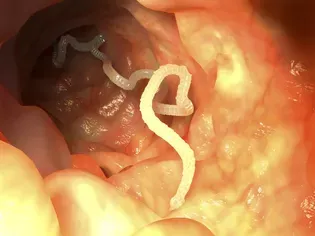Tapeworms in Dogs
Updated on 04/26/24

Tapeworms in Dogs: A Comprehensive Guide to Prevention, Symptoms, and Treatment
Intestinal parasites, such as tapeworms, are a common health concern for dog owners. These parasites can cause a range of symptoms, from mild digestive upset to serious health problems. In this comprehensive guide, we will delve into the world of tapeworms in dogs, exploring their biology, transmission, symptoms, diagnosis, and treatment options.
Understanding Tapeworms
Tapeworms are flat, segmented worms that reside in the intestines of their hosts. They are composed of a scolex (head) and a series of proglottids (segments). The scolex contains hooks or suckers that attach the tapeworm to the intestinal wall. As the tapeworm grows, it sheds mature proglottids, which pass out of the dog's digestive tract in the feces.
Transmission
Dogs can become infected with tapeworms by ingesting infected fleas, rodents, or other animals that carry tapeworm larvae. Fleas are the most common source of tapeworm infection in dogs. When a dog ingests an infected flea, the tapeworm larvae develop into adult tapeworms in the dog's intestines.
Symptoms
The symptoms of tapeworm infection in dogs can vary depending on the severity of the infection. Common symptoms include:
- Weight loss: Tapeworms compete with the dog for nutrients, leading to weight loss.
- Digestive upset: Tapeworms can cause diarrhea, vomiting, and abdominal pain.
- Scooting: Dogs may scoot their rear ends on the ground to relieve the irritation caused by tapeworm segments in the anus.
- Proglotids in the feces: Visible tapeworm segments in the feces are a definitive sign of infection. These segments appear as small, white or cream-colored worms.
Diagnosis
Diagnosing tapeworm infection in dogs is relatively straightforward. The veterinarian will typically perform a physical examination and examine a sample of the dog's feces under a microscope to identify tapeworm eggs or proglottids.
Treatment
Fortunately, tapeworm infection in dogs is highly treatable. The veterinarian will prescribe an oral medication that targets the tapeworm's life cycle. The medication typically kills the adult tapeworm and prevents the development of new worms.
Prevention
Preventing tapeworm infection in dogs is essential for maintaining their overall health. Here are some effective preventive measures:
- Regular flea control: Keep your dog free of fleas by using a monthly flea prevention product.
- Control rodent access: Prevent rodents from entering your home and yard to minimize the risk of exposure to tapeworm larvae.
- Supervise hunting: If your dog hunts for rodents, supervise them closely to prevent them from ingesting infected prey.
- Wash fruits and vegetables: Wash fruits and vegetables thoroughly before feeding them to your dog to reduce the risk of ingestion of tapeworm eggs from contaminated produce.
Case Study: Max the Dog
Max, a young and playful Labrador retriever, began to experience weight loss and digestive upset. His owner, concerned about his symptoms, took him to the veterinarian. The veterinarian examined Max and found several tapeworm segments in his feces. The veterinarian diagnosed Max with tapeworm infection and prescribed an oral medication. After a few days of treatment, Max's symptoms subsided, and his weight began to return to normal. Max's owner diligently followed the veterinarian's instructions for flea control and rodent prevention to prevent future tapeworm infections.
Conclusion
Tapeworm infection is a common but treatable issue in dogs. By understanding the biology, transmission, symptoms, diagnosis, and treatment of tapeworms, dog owners can effectively protect their beloved pets from this parasite. Remember, regular flea control, rodent prevention, and proper hygiene are key to preventing tapeworm infections in dogs. If your dog shows any signs of tapeworm infection, consult your veterinarian promptly for timely diagnosis and treatment.
Explore More Pets

Basic Training
Puppy and Baby Introductions

Working Dog Breeds
All About Search and Rescue Dogs

Dog Treatments
Puppy Vaginitis: Signs, Causes and Treatment

Dog Adoption
After More Than 1,200 Days in the Shelter, Coco Goes Home

Basic Training
How to Train Your Puppy to Go on Potty Pads

Hybrid Dog Breeds
The Difference Between a Mutt, Mixed Breed, or Designer Dog?

Dog Treatments
Nail Problems in Dogs

Puppies
7 Reasons Why Two Dogs Are Better Than One